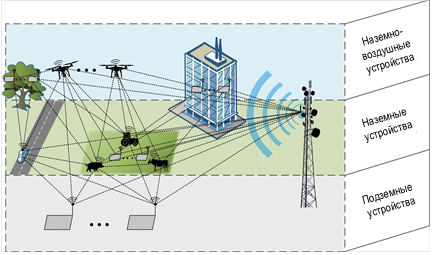
Energy-Efficient Algorithm for Data Path Selection in High-Density Wireless Sensor Networks
https://doi.org/10.31854/1813-324X-2024-10-4-100-109
EDN: VPHYUT
Abstract
Relevance. Increasing the number of sensor devices per unit area consequently reduces the physical distance between the devices in the sensor network. Such networks are usually deployed over a large area and the sensor device that wants to transmit a data packet is located far away from the base station. In such a case, the source device is challenged to choose a transmission path that consumes the least amount of energy resources and satisfies the delivery time requirements.
The objective of this study is to develop and validate the effectiveness of an empirical algorithm for selecting a transmission path that reduces the energy consumption of high-density wireless sensor networks. Methods of system analysis, analytical modeling, geometry and probability theories are used.
Solution. It is assumed that the sensor network is deployed in a limited area and is a set of devices that are connected to each other informationally and energetically. When building data transmission routes, any sensor devices can be used as repeaters. At the same time, the increase in the number of repeaters leads to an increase in the time of data delivery.
Novelty. It is assumed that the sensor network is deployed in a limited area and is a set of devices that are connected to each other informationally and energetically. Any sensor devices may be used as repeaters when constructing data transmission routes.
Significance (theoretical). Dependences of power consumption level on various system parameters affecting the processes of functioning of high-density wireless sensor networks have been obtained.
Significance (practical). The proposed empirical algorithm for selecting a rational data transmission route in a wireless sensor network allows us to determine, among all alternatives, the route to the coordinator that requires the least power. The effectiveness of the proposed empirical power-saving algorithm is confirmed by simulation modeling.
About the Authors
T. N. AstakhovaRussian Federation
M. O. Kolbanev
Russian Federation
A. S. Lyamin
Russian Federation
N. S. Maslov
Russian Federation
D. A. Maslova
Russian Federation
References
1. Romanova A.A. Models and methods for evaluating probabilistic-energetic characteristics of information interaction in the Internet of Things. Phd Theses. St. Petersburg: St. Petersburg State Electrotechnical University “LETI” Publ.; 2023. 21 p. (in Russ.)
2. Almuhaya M.A.M., Jabbar W.A., Sulaiman N., Abdulmalek S. A survey on LoraWAN Technology: Recent Trends, Opportunities, Simulation Tools and Future Directions. Electronics. 2022;11(1):164. DOI:10.3390/electronics11010164
3. Levchenko P., Bankov D., Khorov E., Lyakhov A. Performance Comparison of NB-Fi, Sigfox, and LoRaWAN. Sensors. 2022;22(24):9633. DOI:10.3390/s22249633
4. Zverev B., Sartakov A. SNB new LPWAN technology of “Internet of Things” with high throughput. Control Engineering Russia. 2019;S:38‒41. (in Russ.) EDN:JRNENT
5. Astakhova T.N., Verzun N.A., Kasatkin V.V., Kolbanev M.O., Shamin A.A. Sensor network connectivity models. Information and Control Systems. 2019;5(102):38‒50. (in Russ.) DOI:10.31799/1684-8853-2019-5-38-50. EDN:GLMGRC
6. Tatarnikova T.M., Bimbetov F., Gorina E.V. Algorithm for energy-efficient interaction of wireless sensor network nodes. Scientific and Technical Journal of Information Technologies, Mechanics and Optics. 2022;22(2):294‒301. (in Russ.) DOI:10.17586/2226-1494-2022-22-2-294-301. EDN:FCHFEL
7. Uolles R. Maximum radio communication range in the system: how to achieve this? News of Electronics. 2015;11:3‒13. (in Russ.)
8. Kolbanev M.O., Tatarnikova T.M. Physical resources of information processes and technologies. Scientific and Technical Journal of Information Technologies, Mechanics and Optics. 2014;6(94):113–123. (in Russ.) EDN:TBDGTL
9. Aung T.A. Development of methods and means of protected data collection of Internet of Things (IoT) districts. Phd Theses. St. Petersburg: ITMO University Publ.; 2020. 297 p. (in Russ.)
10. Astakhova T.N., Kirilova D.A., Kolbanv M.O., Maslov N.S., Shamin A.A. Criterion for selecting the optimal route of message transmission in wireless sensor networks. Telecommunications. 2020;7:6‒12. (in Russ.) EDN:VIEYJZ
11. Astakhova T.N., Verzun N.A., Kasatkin V.V., Kolbanev M.O., Shamin A.A. Sensor network connectivity models. Information and Control Systems. 2019;5(102):38‒50. (in Russ.) DOI:10.31799/1684-8853-2019-5-38-50. EDN:GLMGRC
12. Kocakulak M., Butun I. An overview of Wireless Sensor Networks towards internet of things. Proceedings of the 7th Annual Computing and Communication Workshop and Conference, CCWC, 09‒11 January 2017, Las Vegas, USA. IEEE; 2017. DOI:10.1109/CCWC.2017.7868374
13. Mahlknecht S., Madani S.A., Roetzer M. Energy aware distance vector routing Scheme for Data Centric Low Power Wireless Sensor Networks. Proceedings of the 4th IEEE International Conference on Industrial Informatics, 16‒18 August 2006, Singapore. IEEE; 2006. p.1030‒1035. DOI:10.1109/INDIN.2006.275739
Review
For citations:
Astakhova T.N., Kolbanev M.O., Lyamin A.S., Maslov N.S., Maslova D.A. Energy-Efficient Algorithm for Data Path Selection in High-Density Wireless Sensor Networks. Proceedings of Telecommunication Universities. 2024;10(4):100-109. (In Russ.) https://doi.org/10.31854/1813-324X-2024-10-4-100-109. EDN: VPHYUT


































